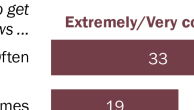Big Versus Small Owners
To examine size, we separated the TV companies studied into four categories, using the FCC rankings of audience reach1: the 10-largest TV groups; groups 11 through 25 in terms of audience reach; medium sized companies (any company below the top 25 in reach and owning at least four stations); and small companies (companies below the top 25 in audience reach and owning three stations or fewer). In our sample, there are 65 stations owned by the top-ten media companies, 47 owned by the top 11-25 companies, 37 mid-size-company stations and 23 small-company stations.
Here we found clear distinctions. The smallest companies produced higher quality newscasts.
Are there certain qualities that characterize larger companies versus smaller ones?
In general, small company stations are more local, do more enterprise, source stories better and air more long stories.
Size seemed to have no bearing on how many sources stations cite in their stories, the level of balance in newscasts or the tendency of stations to focus stories around their larger implications.
In the areas where size did make a difference:
|
Size of Corporate Owner and Enterprise
|
||||
| Enterprise |
Top 10 Groups
|
11-25 Groups
|
Midsize Groups
|
Small Groups
|
| Investigations, interviews, news series |
7%
|
7%
|
8%
|
7%
|
| Spontaneous event coverage |
22
|
21
|
20
|
23
|
| Prearranged event covered w/ reporter |
22
|
25
|
31
|
26
|
| Prearranged event covered w/o reporter |
23
|
24
|
23
|
21
|
| Wire/feed/other news organization, VNRs |
23
|
20
|
14
|
20
|
| Other |
3
|
3
|
4
|
3
|
| Total |
100%
|
100%
|
100%
|
100%
|
On Enterprise: Across the board in local television, we have seen enterprise declining. The percentage of stories with reporters on the scene is down. The use of syndicated material and wire feeds is up. The percentage of stories in which a station sends a camera but no reporter is rising.
Here the data suggest size plays a part, but the very smallest companies were not necessarily the best. Rather, mid-sized companies-those with four stations or more but not in the top 25 companies-showed the most enterprise. They were followed by the smallest companies. The top 10 and 11-25 companies in the country fared worst.
In particular, mid-sized-owned stations were the most likely to send a reporter to the scene of a story (31%), followed by the smallest owned-stations (26%). The biggest companies were least likely to do so (22% for the top 10).
Similarly, mid-sized companies were less likely than larger ones to base stories on syndicated material, wire feeds, reports from other news organizations or from corporate press releases (14% at mid-sized companies, versus 23% at top ten).
When it came to investigative reporting, size made no difference. The numbers here are small across the board. In all, only one percent of local television stories were investigative.
On Local Relevance: Size also seems to matter when it comes to how well stations do at making stories locally relevant. Mid-sized companies scored best, followed by the smallest companies.
For instance, four-in-ten stories at small and mid-size-company stations involved issues that affected the entire viewing community, compared with about a third at the biggest owned stations.
Mid-sized and small companies were also slightly less likely to air stories with no connection to the local community-such as a car chase from a faraway town, or a distant sensational crime story. Mid-sized company stations aired the least of such stories (9%). Small-company stations, with presumably the fewest resources, were second lowest (12%). Top-ten sized stations aired the most (15%), the next biggest companies followed (14%).
Smaller companies also aired more stories about local topics in general. Fully 86% of stories from mid-sized owners and 80% of stories from small-sized owners were local, compared to slightly less, 77% from top ten owners.
|
Size of Corporate Owner and Localism
|
||||
| Localism |
Top 10 Groups
|
11-25 Groups
|
Midsize Groups
|
Small Groups
|
| National story with explanation of local impact |
6%
|
4%
|
4%
|
4%
|
| Story affecting main viewing area |
33
|
35
|
39
|
39
|
| Story affecting local subgroup or institution |
25
|
26
|
27
|
24
|
| Nat’l./int’l. story w/ no explanation of local impact |
15
|
14
|
9
|
12
|
| Feature, no local impact |
21
|
21
|
21
|
21
|
| Total |
100%
|
100%
|
100%
|
100%
|
On Sourcing: The smallest owners were slightly more likely to have a credentialed expert in the story than the largest owners (27% versus 23% among top ten).
When it comes to the number of sources in a story, or even the number of viewpoints, having the biggest or smallest owner seemed to make no difference.
On Story Length: Whether a story was long or short is not a part of a station’s quality grade. But in each year of the study, stations that aired more long stories and fewer very short stories enjoyed better ratings trends. They also tended to score higher for quality.
When we examined stations by company, we found that indeed the smallest-owned stations did produce more long stories, though by small margins. These stations average 37% of their stories over 1 minute compared to 33% at the top ten and the top twenty-five, a marginal difference.
Perhaps slightly more telling, the data offers evidence of small stations doing fewer very short stories. Stories under 20 seconds accounted for 12% of those on small-company and mid-size company stations versus 17% at top ten and 19% at the top twenty-five.
Why would bigger companies not fare as well as small? Wouldn’t they have potentially more expertise to draw on, better research and more experienced staff?
One possible explanation is that when a company owns several dozen stations, particularly a company engaged in many activities other than local TV news, the content on those local stations becomes more difficult to track. Individual properties can more easily blur. It may become easier to develop something of a financial portfolio mentality, seeing properties primarily as items on a balance sheet. This is only one possible explanation.
Another possibility is that local news stations owned by big companies may feel added pressure of a certain kind. There may be more intense concern with helping subsidize other operations or to take advantage of synergy opportunities. All of this may tend to relegate quality as a concern, or make it more difficult to balance against other concerns.
Further analysis would require more information, such as a comparative examination of specific stations and specific companies, to determine why some stations owned by big companies score better than others and whether some big companies overall score better than others. Such an analysis is beyond the scope of this study.
1. Our measurement of audience reach followed the FCC’s policy of discounting for the difference between the reach of UHF versus VHF stations.




